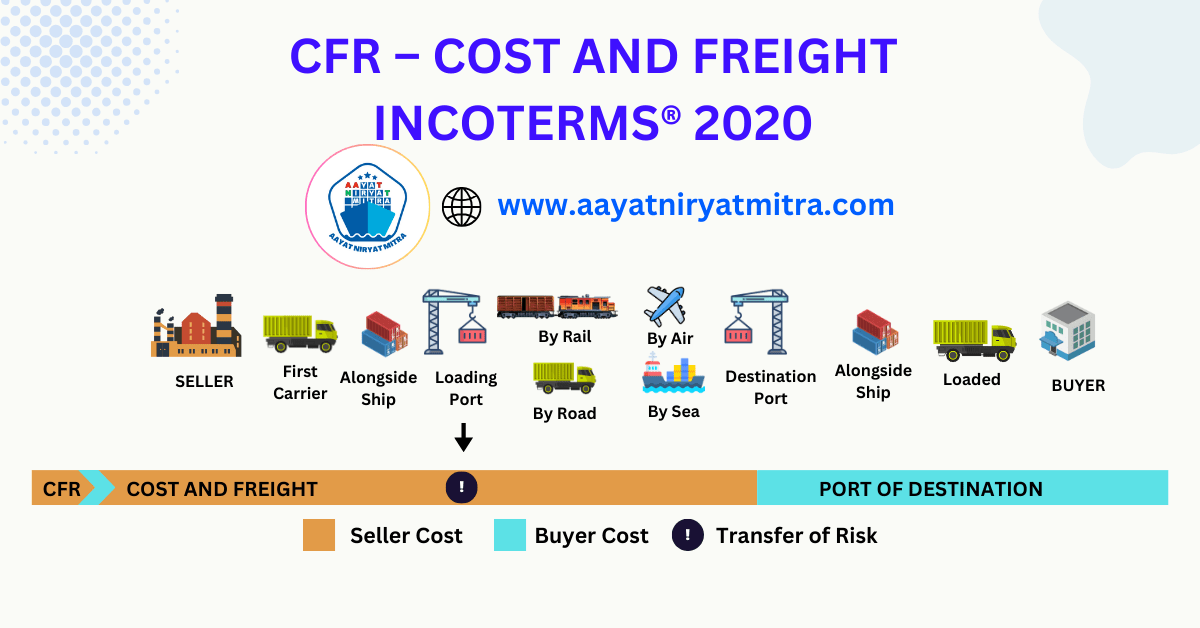Explore the world of CFR – Cost and Freight Incoterms. Learn how these trade rules simplify international shipping and reduce costs for businesses.
Understanding CFR Incoterms®
What Are CFR Incoterms?
CFR is an acronym that stands for “Cost and Freight,” and it is one of the internationally recognized Incoterms used in global trade. CFR specifies the roles of buyers and sellers in terms of product delivery, cost allocation, and risk transfer. The seller is responsible for organizing and paying for transportation to the stated port of destination, including freight costs, under CFR rules.
How Do CFR Incoterms Benefit Buyers?
- Clear Cost Structure: CFR words provide customers with a clear breakdown of expenses, making budgeting and financial planning easier.
- Risk Transfer: Once the products are placed into the vessel, risk moves from the seller to the buyer, providing buyers with greater choice over insurance coverage.
- Cost Savings: Because the vendor is responsible for shipment, buyers may frequently negotiate lower freight rates.
How Do CFR Incoterms Benefit Sellers?
- Simplified Delivery: Sellers are responsible for delivering products to the designated port of destination, which streamlines the export procedure.
- Reduced Liability: Once the items are carried onto the vessel, the seller’s liability lowers, lowering exposure to potential losses during transportation.
- Versatility: CFR provisions apply to all means of transportation, providing sellers in a variety of sectors with flexibility.
Is CFR Suitable for Small Businesses?
Yes, CFR Incoterms are appropriate for companies of all sizes. Small firms, like bigger enterprises, may benefit from the clarity and cost-effectiveness that CFR terms provide.
Can CFR Be Used for Both International and Domestic Trade?
CFR applies to both foreign and domestic trade. Its adaptability makes it suitable for a wide range of transactions.
What Documents Are Associated with CFR?
The commercial invoice, bill of lading, packing list, and any other paperwork necessary by the buyer or importing nation are all common documents linked with CFR.
Can CFR Be Combined with Other Incoterms?
When dealing with complicated transactions, CFR might be paired with other Incoterms. However, it is critical to precisely outline each party’s duties in the contract.
Example of CFR
Buying Onion from Nashik JNPT Port – CFR
Step 1: Seller prepares the onions for export
- The seller in Nashik packs the onions in appropriate packaging and labels them correctly.
- The seller clears the onions for export with the Indian customs authorities.
Step 2: Seller transports the onions to JNPT port
- The seller transports the onions from Nashik to JNPT port by truck or train.
Step 3: Seller arranges for ocean freight
- The seller books the onions on a ship to the buyer’s destination port.
- The seller pays for the ocean freight costs.
Step 4: Seller loads the onions onto the ship
- The seller loads the onions onto the ship at JNPT port.
Step 5: Seller provides the buyer with all necessary documentation
- The seller provides the buyer with all necessary documentation, such as commercial invoices, packing lists, and bills of lading.
Step 6: Buyer is responsible for all costs and risks from the point at which the onions are loaded onto the ship
- The buyer is responsible for all costs and risks, including insurance and import duties, from the point at which the onions are loaded onto the ship.
Additional things to keep in mind:
- The buyer should make sure that they have arranged for insurance coverage for the onions from the point at which they are loaded onto the ship.
- The buyer should be aware of the import duties and taxes that will be payable when the onions arrive at their destination port.
Benefits of using CFR Incoterms® 2020:
- CFR is a relatively straightforward Incoterm, which can help to reduce costs and avoid disputes.
- CFR gives the buyer more control over the shipping process, as they are responsible for choosing their carrier and arranging for insurance.
- CFR can be a good option for buyers who are unfamiliar with the shipping process or who do not have a network of reliable shipping partners.
Drawbacks of using CFR Incoterms® 2020:
- CFR is not ideal for buyers who are on a tight budget, as the buyer is responsible for all costs and risks from the point at which the goods are loaded onto the ship.
- CFR can be risky for buyers if they do not have adequate insurance coverage.
- CFR can be more complex for shipments involving multiple vessels or ports of call.
Comparison of CFR and FOB Incoterms® 2020:
CFR and FOB are similar Incoterms, but there are a few key differences. Under CFR, the seller is responsible for arranging for ocean freight, but the buyer is responsible for all costs and risks from the point at which the goods are loaded onto the ship. Under FOB, the seller is responsible for loading the goods onto the buyer’s ship, but the buyer is responsible for all costs and risks from that point forward.
In general, CFR is a more comprehensive Incoterm for the buyer, as it includes the cost of ocean freight. However, FOB can be a better option for buyers who have transportation arrangements or who want to have more control over the loading process.
FAQs Cost and Freight (CFR):
-
Q: How does risk transfer work under CFR Incoterms?
Ans: The risk passes from the seller to the buyer once the products are placed aboard the vessel at the stated port of shipping under CFR Incoterms. To adequately handle this risk, all parties must have adequate insurance coverage.
-
Q: How do you calculate Incoterm CFR?
Ans: To calculate the CFR price, you need to add the cost of the goods to the freight cost.
CFR price = cost of goods + freight cost -
Q: What does the CFR Incoterms rule mean by Cost and Freight?
Ans: The CFR Incoterms rule, or Cost and Freight, means that the seller is responsible for delivering the goods to the port of destination specified by the buyer and paying for the freight costs. The risk of loss or damage to the goods passes from the seller to the buyer when the goods are loaded onto the vessel at the port of departure.
-
Q: Who pays freight in CFR Incoterm?
Ans: The seller pays for the freight costs in CFR Incoterm.
-
Q: What factors should you consider when deciding which Incoterms to use?
Ans: When deciding which Incoterms to use, you should consider the following factors:
– The type of goods being shipped
– The mode of transportation being used
– The origin and destination of the goods
– The level of risk and responsibility that each party is willing to take on -
Q: Does CFR include freight?
Ans: Yes, CFR includes freight. The seller is responsible for paying for the freight costs to transport the goods to the port of destination specified by the buyer.
-
Q: Is CFR cheaper than CIF?
Ans: Yes, CFR is cheaper than CIF. The seller does not have to pay for marine insurance under CFR, which is required under CIF.
-
Q: How are Incoterms costs calculated?
Ans: The cost of Incoterms is calculated by adding up the costs of all of the tasks that the seller is responsible for under the chosen Incoterms rule. For example, under CFR, the seller would add up the cost of the goods, the freight cost, and any other costs associated with delivering the goods to the port of destination specified by the buyer.
-
Q: How do you convert FOB to CFR?
Ans: To convert FOB to CFR, you need to add the freight cost to the FOB price.
CFR price = FOB price + freight cost -
Q: What does CFR price include?
Ans: The CFR price includes the cost of the goods and the freight cost to transport the goods to the port of destination specified by the buyer. It does not include the cost of marine insurance.
Conclusion:
CFR Incoterms® 2020 is a popular Incoterm for international trade, especially for bulk cargo and other types of cargo that are difficult or expensive to load onto ships alongside other vessels. It is a relatively straightforward Incoterm, which can help to reduce costs and avoid disputes. However, it is important to be aware of the risks and responsibilities involved before using CFR.
If you are considering using CFR Incoterms® 2020, it is important to consult with a qualified trade professional to understand your specific needs and responsibilities.
If you discover an error in the “CFR – Cost and Freight Incoterms®2020: A Comprehensive Guide” information provided to us, please notify us immediately via the comment box and email; if the information provided by you is correct, We will change it.
If you enjoyed this article, please share it with your friends. Please visit Aayat Niryat Mitra for more information on this and other topics. Thank you for stopping by.

